
The iPhone 15 Plus has carved out its niche this year, with a discounted price in the UK along with several previously Pro-exclusive features like Dynamic Island tech, a new 48MP camera and impressively strong battery life that make it a tempting alternative to the top-end iPhone 15 Pro Max – it’s just a shame about the 60Hz refresh rate.
Pros
- Large 6.7-inch OLED display
- Exceptional camera performance
- Rounded edges make it nice to hold
Cons
- Display capped at 60Hz
- No telephoto camera
- Slow charging, even with USB-C connectivity
Key Features
- Capable dual-camera setupIt might not get the telephoto lens of the Pro models, but the dual camera setup – and the main 48MP camera in particular – offers strong performance in all lighting conditions.
- A16 Bionic chipsetThe year-old chipset may put some off, but the A16 Pro has more than enough power to deliver a strong everyday performance – and it still outpaces much of the Android competition.
- Dynamic Island techPreviously exclusive to the Pro iPhones, Dynamic Island is essentially a redesigned Face ID notch that brings the cutout into the software experience, displaying handy information at a glance.
Introduction
The iPhone 15 Plus is here to fix the wrongs of last year’s 14 Plus, a phone that didn’t really sit comfortably in Apple’s line-up.
However, with this year’s iPhone 15 Plus getting serious upgrades in the form of Dynamic Island tech, a new 48MP snapper and a slightly cheaper price point in the UK, it represents a more tempting choice for anyone looking for a big-screen iPhone that doesn’t want to pay top dollar for the iPhone 15 Pro Max.
Sure, there are still compromises to be had – you miss out on a telephoto sensor, the A17 Pro chipset and a titanium chassis – but these aren’t enormous omissions for the everyday iPhone user.
The only big complaint I have is that the screen is still locked to a sluggish 60Hz when even sub-£200 Android smartphones offer a smooth 120Hz refresh rate – something I hope Apple changes with the iPhone 16 Plus next year.
Design
- Slightly updated design with softer edges
- New matte finish on the rear
- Move from Lightning to USB-C
You might be hard-pressed to tell the difference between the iPhone 15 Plus and its predecessor, the iPhone 14 Plus. It’s still very much a distinctive iPhone with no huge redesign on offer, though picking up the newer model, you’ll notice subtle differences.
That’s because the aluminium frame has done away with the signature sharp edges of previous iPhones, this time opting for a slightly rounded affair that instantly makes the large 6.7-inch phone feel more comfortable in the palm of the hand. I never really minded the more angular edges of older models at the time, but after handling the iPhone 15 Plus, I don’t really want to go back.
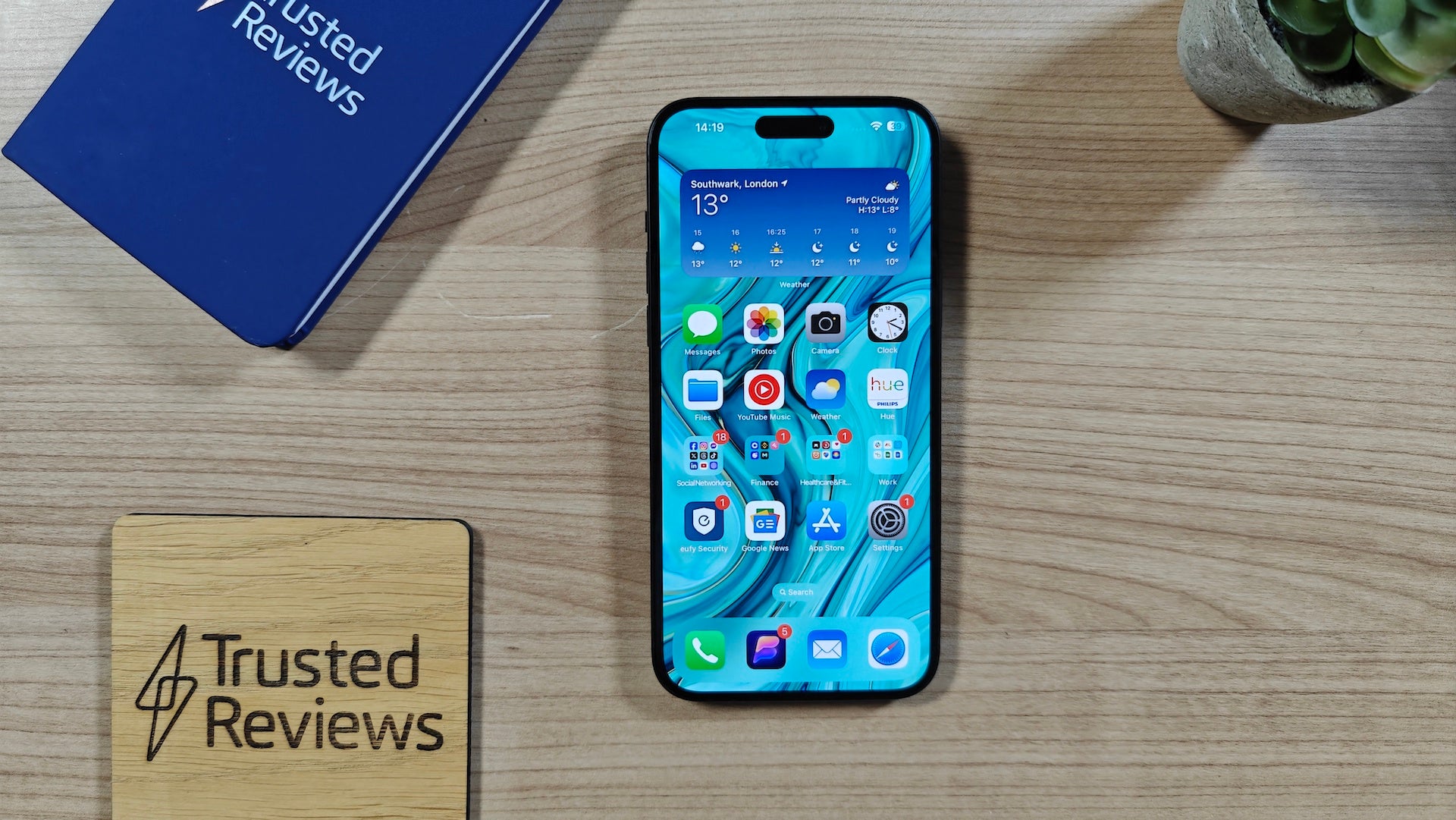

That’s accompanied by a nice new matte finish on the glass rear that helps get rid of those annoying fingerprints, and the satin-like feel provides a lovely sensation for the fingertips too. That’s accompanied by the dual camera bump in the top-left, though like the frame, the corners of the cutout are somewhat softer and more sloped this time around.
The iPhone 15 Plus is slightly lighter than its predecessor at 201g, though only by three grams. The bigger weight difference comes with the iPhone 15 Pro and iPhone 15 Pro Max, which swapped out the weighty stainless steel frame for a more lightweight titanium one.
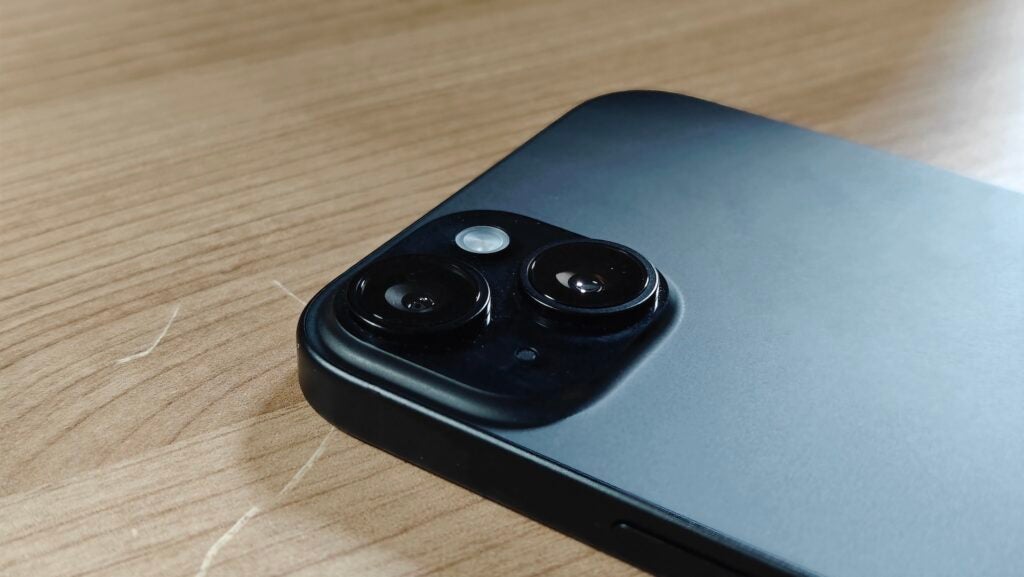
While on the subject of Pro comparisons, the one instantly noticeable difference between the iPhone 15 Plus and its Pro Max sibling is the lack of an Action Button. The new button replaces the volume switch present on previous models, but this is very much a Pro-level upgrade with both the iPhone 15 and 15 Plus offering the same traditional switch.
It’ll likely trickle down to the regular iPhones at some point, as with Dynamic Island, but I imagine it’ll be a couple of years away yet.
If you follow that aluminium frame to the bottom of the iPhone, you’ll notice another difference: a USB-C port, in place of the Lightning port Apple has used since 2012. It’s likely a change that’ll split opinion, especially if you have a large ecosystem of Lightning cables and accessories, but I loved the ability to use one USB-C cable to charge my MacBook, iPad Pro and iPhone.
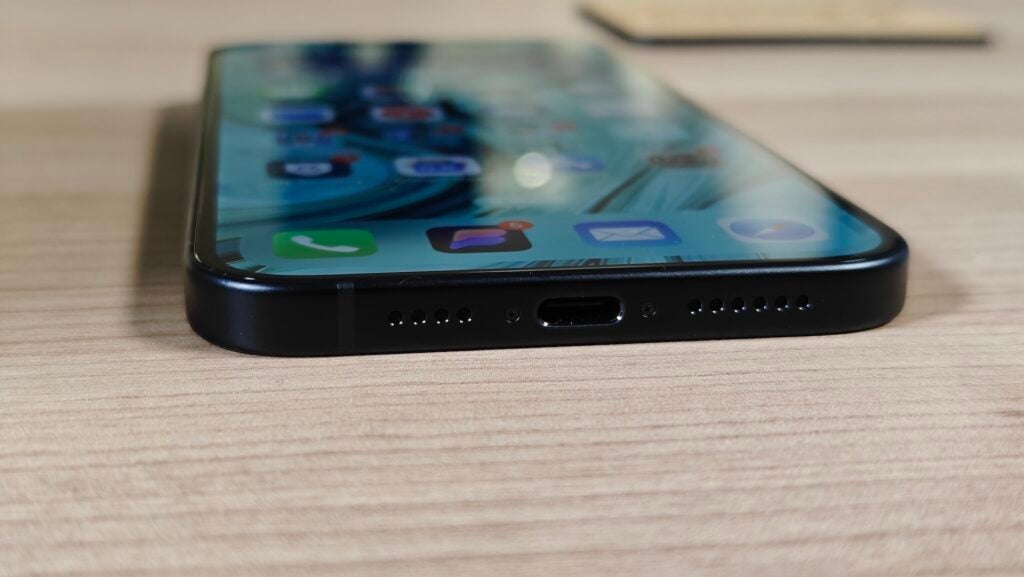
Elsewhere, the iPhone 15 Plus is IP68 dust- and water-resistant to protect it from unexpected dunks, and it comes in a range of attractive – if slightly muted – colours including black, white, blue, green, yellow and pink.
Apple has to be applauded for its approach to environmental practices too, with the iPhone 15 Plus’ chassis made from 75% recycled materials, while the battery includes 100% recycled cobalt. The packaging is also completely recyclable, with no single-use plastics in sight.
Apple also has plans to make its phones carbon-neutral, but it hasn’t achieved that lofty aim just yet.
Screen
- 6.7-inch OLED display
- Dynamic Island technology
- Capped at 60Hz
The large 6.7-inch OLED display is the main reason to opt for the iPhone 15 Plus over the cheaper iPhone 15. It’s a high-quality panel with a pixel-packed 1290 x 2796 resolution that delivers oodles of detail, whether you’re scrolling through Instagram or playing detailed 3D games like Genshin Impact.
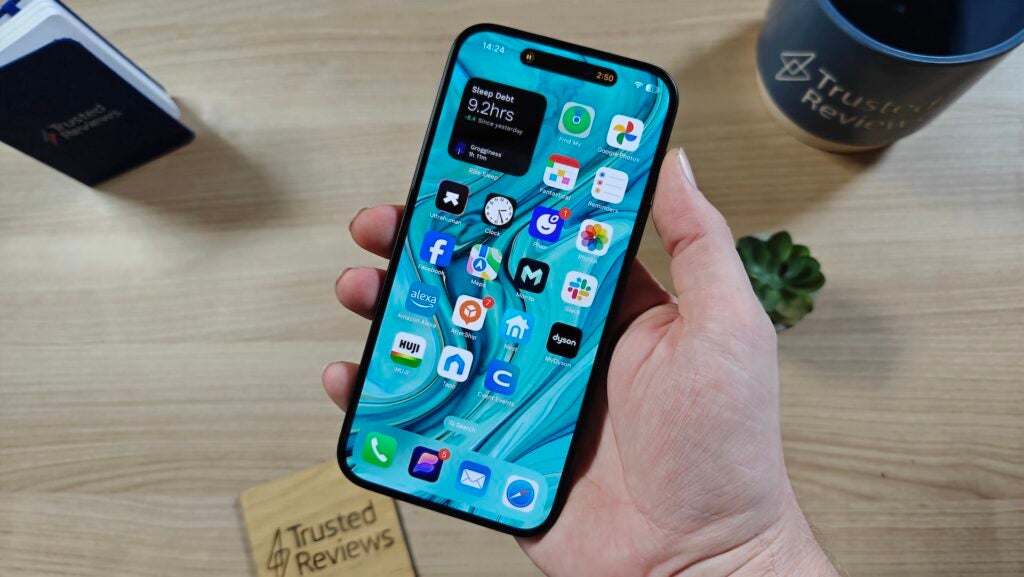
While it’s largely the same as last year’s iPhone 14 Plus, the addition of the previously Pro-exclusive Dynamic Island tech makes for an exciting change. The pill-shaped cutout replaces the iconic notch cutout, hiding both the selfie camera and Face ID tech within, as well as working with iOS to make it a core part of the experience.
This is done in several ways, from providing a mini player to control music playback to constantly displaying a currently running timer, and some third-party apps have built specific Dynamic Island functionality into their apps, allowing you to get live delivery updates or football scores without delving into the app in question.
It’s a cool feature that has been pretty underutilised by developers up until now, but with more iPhones now using the tech, we could see an explosion in Dynamic Island integration in the coming months.
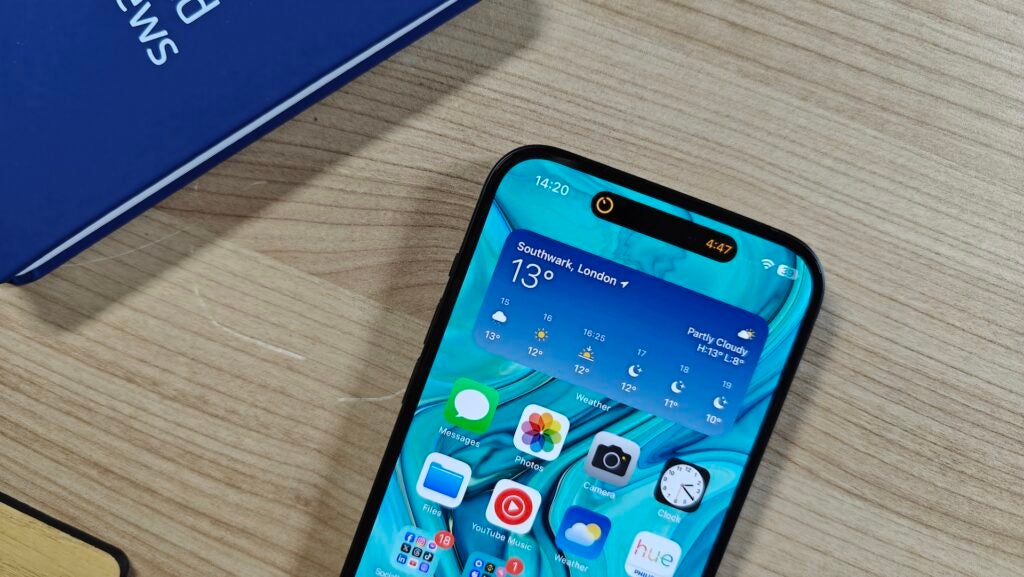
The panel can also reach a much higher peak brightness at an impressive 2000nits which makes watching HDR content a real treat, especially when combined with the vibrant colours and inky blacks of the OLED panel.
There isn’t much to be disappointed about with the iPhone 15 Plus display, then – aside from the refresh rate. The iPhone 15 Plus continues Apple’s (quite unbelievable) stance of keeping the regular models locked to a rather slow 60Hz, leaving the ProMotion 120Hz display tech exclusive to the iPhone 15 Pro and iPhone 15 Pro Max.
Compared to practically every other Android smartphone, even budget options like the £349 Honor Magic 5 Lite that offers a 120Hz refresh rate, the iPhone feels comparatively slow and sluggish. People like to argue that nobody even notices the difference, and while that may be true for those who haven’t used a 120Hz display over a long period, it’s certainly notable for those of us who have.
Besides, the only reason most iPhone users are yet to experience it is that Apple has been gate-keeping the tech for its top-end smartphones for way too long. It’s time to demand more from what is, by all means, a flagship smartphone, even without the Pro moniker.

Cameras
- New 48MP primary sensor
- Capable in well-lit and low-light conditions
- High-quality video capture
While a glance at the rear of the iPhone 15 Plus will reveal the same dual-camera design as its predecessor, it holds a secret within. That secret? A shiny new 48MP primary snapper, replacing the 12MP camera Apple has used for quite some time.
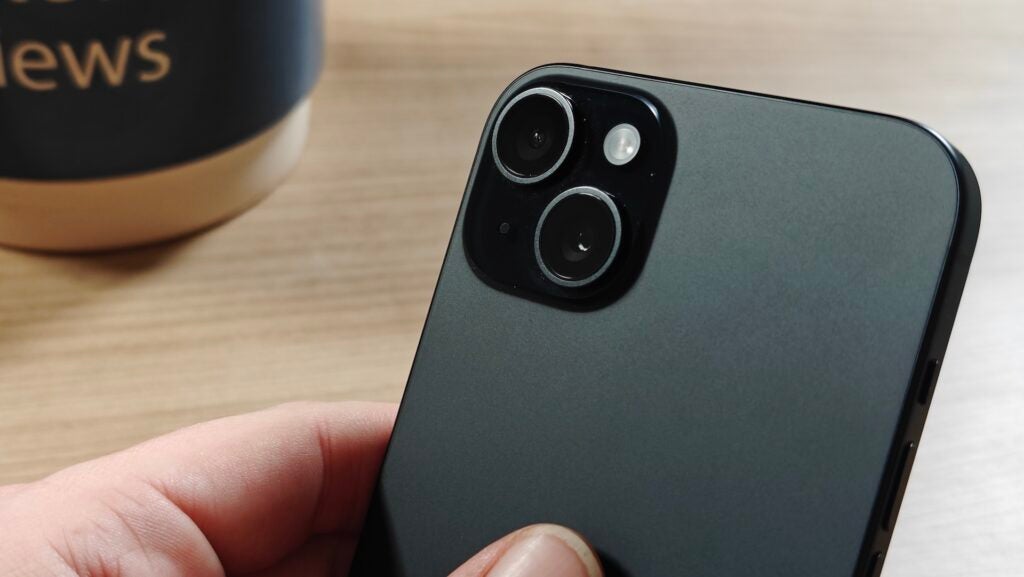
Of course, the megapixel count doesn’t always have a direct effect on image quality – something Apple has proved time and time again – but it does grant the regular iPhone pixel-binning technology that delivers a massive improvement in overall light and detail, particularly in low-light scenarios.
Low light is one area where the iPhone 15 Plus has seen a considerable improvement year-on-year, delivering shots not that far off what you’ll get from the iPhone 15 Pro. It was quickly able to capture images in even extremely dim situations, like a moonlit lawn, though it can sometimes look a little too orange.






In more general use, the iPhone 15 Plus’ primary sensor is an absolute treat, capable of capturing bright, detailed and vibrant images with a perfectly balanced dynamic range that is perfect for sharing on social media.







An update to the camera tech also allows you to transform any photo into a Portrait-style photo, with users able to tweak both the focus and the bokeh of the image in the Photos app at any point. You’re able to tweak focus and bokeh post-capture on some Android phones, but not many (if any at all) can convert regular images to Portrait shots with such accuracy.
The new 2x digital zoom option provided by the high-res 48MP sensor is also a handy addition, allowing you to get a little closer to the subject (for Portrait shots, for example) without having to get physically closer, and without any real notable downgrade to overall image quality. It also provides a slightly narrower field of view than the primary and ultra-wide lenses.




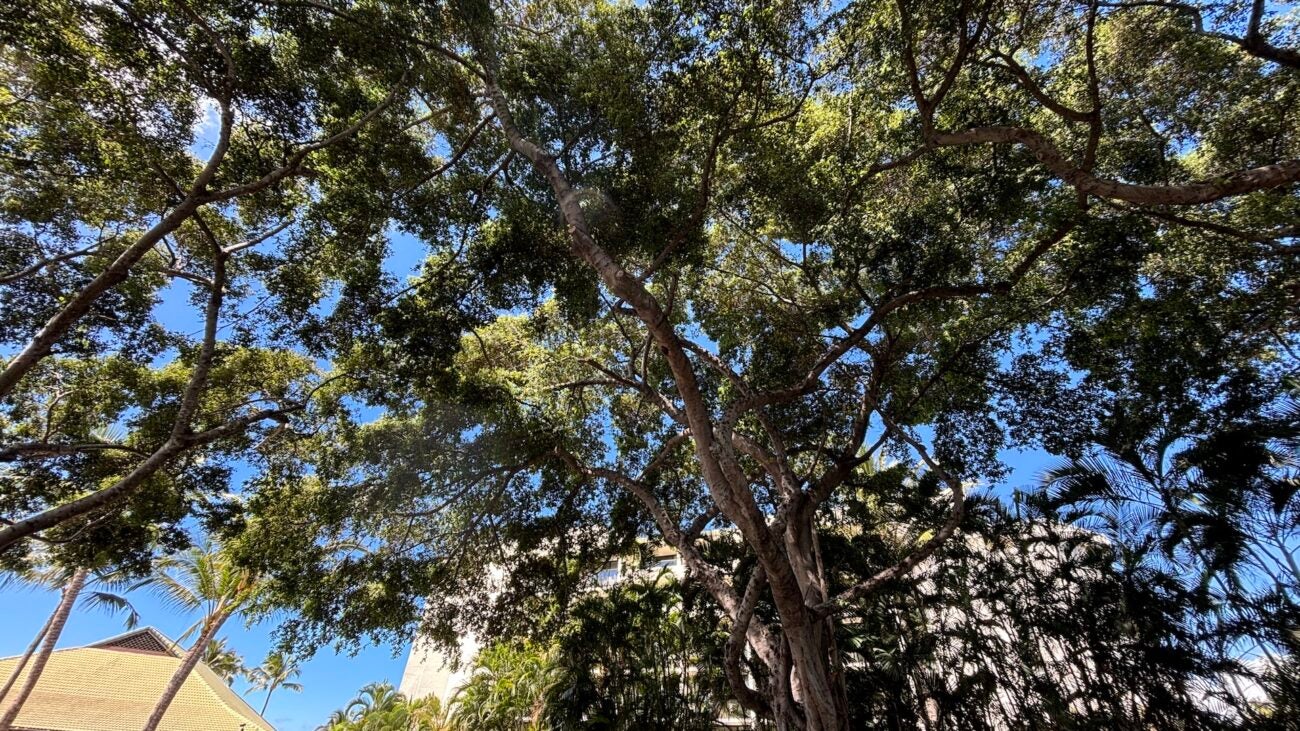
Speaking of, there has been little in the way of improvements to the accompanying 12MP ultrawide lens. That is to say that it still takes a great photo with plenty of detail and a consistent colour palette compared to the primary lens, but you won’t find any fancy pixel-binning tech here to further enhance the more minor details of images taken.
It also means it’s still not the best when it comes to night mode, with notably darker, muddier shots than the accompanying lens.



Video remains one of the strongest points for getting an iPhone over practically any Android on the market, with sweeping cinema-style stabilisation that looks great. There’s also the ability to record at up to 4K@60fps with stabilisation, along with Cinematic Mode (that dynamically blurs the background) at 4K@30fps.
The latter is a little slower than the 4K@60fps of the Pro models, and you won’t find ProRes or Log capture, but for all but pro-level video editors, that doesn’t matter too much.
Performance
- A16 Bionic chipset
- Can still outpace Android competitors
- eSIM is still only a requirement in the US
At the heart of the iPhone 15 Plus you’ll find the 4nm A16 Bionic chipset – and if that chipset sounds familiar, it’s because it should. It’s the same chipset that was previously exclusive to the iPhone 14 Pro, but don’t let that put you off.
Even when combined with less RAM (6GB) than the Pro models, the A16 Bionic is a performant chipset that can still bring the fight to flagship Android competition a year after release – something backed up by our suite of benchmark tests, showcasing just how capable the iPhone 15 Plus is.
Sure, it’s a way off the 3nm A17 Pro of this year’s Pro collection, but you won’t be able to tell a difference in day-to-day tasks. The iPhone 15 Plus feels just as rapid as any other flagship smartphone, handling both scrolling through media-heavy apps and high-end games like Call of Duty Mobile with high graphics enabled without as much as a hint of stutter.
That may change somewhat in future, with console-level games like Resident Evil Village and Death Stranding coming to the more powerful iPhone 15 Pro, but for all but the most power-hungry users and top-end gamers, you aren’t missing out on much.

One of the only elements holding things back is the aforementioned 60Hz refresh rate, which isn’t quite as smooth as the 120Hz panel found in most of the competition. It’s just as fast, but smoother displays can feel more responsive in everyday use.
When it comes to connectivity, expect the standard slate including Bluetooth 5.3, NFC for Apple Pay and Wi-Fi 6 (6E is exclusive to the Pro models). It’s also eSIM only in the US, as with last year’s collection, though that hasn’t become more widespread with the release of the iPhone 15 as some had expected.
Software
- Runs iOS 17
- Works well with other Apple devices
- Long OS upgrade promise
One of the biggest reasons to get an iPhone is to get access to iOS, Apple’s home-grown operating system for its mobile collection. More specifically, the iPhone 15 Plus sports the latest iteration in the form of iOS 17, bringing with it a swathe of new features that improve the iPhone experience on offer.
That includes big headline new features like Standby Mode which essentially turns the iPhone 15 Plus’ sizeable 6.7-inch display into a smart display when either connected by MagSafe or USB-C in a landscape orientation, to more minor, yet still vital, additions like interactive widgets on the home screen and lock screen.
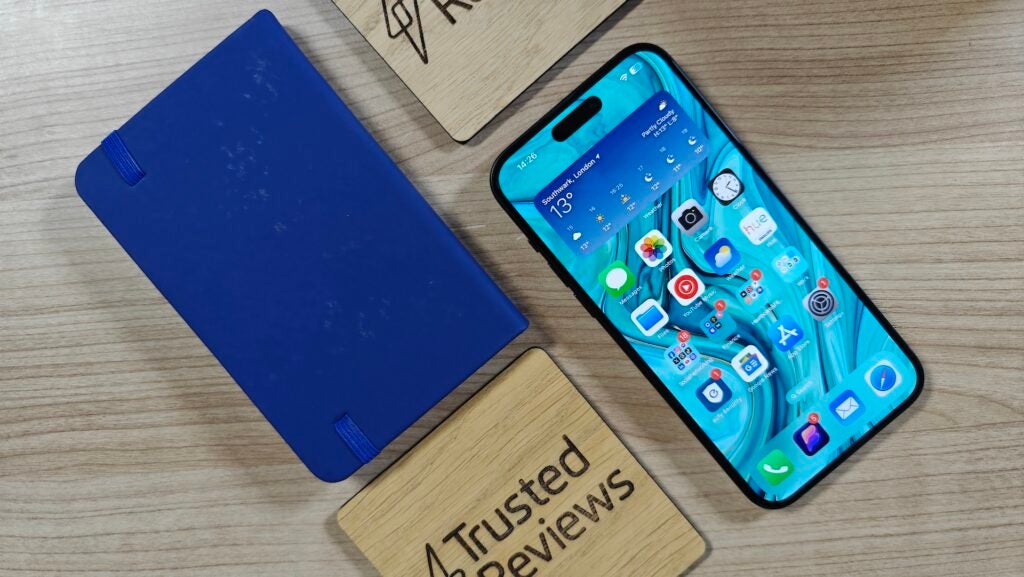
There’s also new Contact Poster functionality, as well as an improved layout in the Messages app, new FaceTime functionality and an upgraded way to use AirDrop between iPhones, all of which change the way you interact with your iPhone daily.
New features aside, the iOS experience is a clean and polished one that’s further improved by how well Apple tech like AirPods and Apple Watch work together with the iPhone.
Of course, it’s not just the iPhone 15 range that gets access to iOS 17. All the features part of iOS 17 mentioned here are also available on every iPhone back to the iPhone Xr, a phone first released in 2018.
By that metric, I expect the iPhone 15 Plus to continue to get software updates until iOS 23, meaning the leading software experience will continue to improve over time with new features and functionality, much like a fine wine.
Battery life
- Incredibly strong battery life
- Could make it into a second day of use
- USB-C doesn’t make charging faster
Battery life is one area where the iPhone 15 Plus excels compared to most of the iPhone 15 range, and that includes the top-end Pro Max. That’s largely down to the combination of a static 60Hz display and a very big battery, both of which equate to excellent battery life that, depending on usage, could see you well into a second day of use.
Apple doesn’t like to comment on battery specifics but third-party teardowns have revealed the use of a 4,383mAh cell, a meagre improvement on last year’s 4,325mAh cell. However, combined with the 4nm A16 Bionic, I found the iPhone 15 Plus would simply keep on going – and that’s even during 18+ hour days at a recent smartphone conference I was attending.

In fact, on one day of the conference, the iPhone was used for around 18 hours with a combination of 6 and a half hours of screen-on time and another 2 hours of screen-off usage listening to music, and I still had 34% left in the tank when I went to plug it in at around midnight.
Considering plenty of Android phones falter at around the 5-hour mark, it certainly alleviated my battery anxiety and allowed me to leave my chunky power bank in my hotel room.
However, despite the move to USB-C, the iPhone 15 Plus charges at the same rates as its Lightning-enabled counterparts from 2022, and it’s a similar story with data transfer too.
That means the iPhone 15 Plus took 27 minutes to hit the 50% mark and 93 minutes to reach a full charge via the (nicely braided and colour-matching) USB-C cable provided in the box – though as with all other recent iPhone releases, you’ll have to source your own charging brick to juice it up.
Qi and MagSafe also make a return at the same 7.5W and 15W respectively, offering a more convenient, if not slightly slower, way to charge your iPhone.
Latest deals
Should you buy it?
You want a big-screen iPhone without the price
The size of the 6.7-inch display of the iPhone 15 Plus perfectly matches the iPhone 15 Pro Max, giving you the core big-screen experience without splashing out for the top-end model.
You want the best camera tech
While the primary 48MP camera represents a considerable upgrade, the iPhone 15 Plus misses out on the 3.5x or 5x telephoto lens of the Pro models, making it harder to get closer to the subject without physically moving.
Final Thoughts
The iPhone 15 Plus makes more sense in Apple’s line-up compared to last year’s iPhone 14 Plus, partly because of a price drop in the UK that more comfortably separates it from the top-end iPhone 15 Pro and iPhone 15 Pro Max without a massive downgrade in terms of features and functionality.
Sure, you’re not getting a telephoto lens or the fastest Apple chipset, but the iPhone 15 Plus has a lot going for it, from the new Dynamic Island tech to the new 48MP primary camera that delivers true year-on-year gains when it comes to taking photos and capturing videos.
It also still delivers the best battery life of any iPhone, with even hardcore use not fully draining the battery over a day.
So, if you want a big-screen iPhone without paying a premium for the iPhone 15 Pro Max, the iPhone 15 Plus is a comfortable alternative.
How we test
We test every mobile phone we review thoroughly. We use industry-standard tests to compare features properly and we use the phone as our main device over the review period. We’ll always tell you what we find and we never, ever, accept money to review a product.
Find out more about how we test in our ethics policy.
Used as a main phone for over a week
Thorough camera testing in a variety of conditions
Tested and benchmarked using respected industry tests and real-world data
FAQs
You’ll get a USB-C to USB-C cable in the box, but no charging brick. You’ll have to source your own separately to take advantage of the fastest charging speeds possible.
With an IP68 rating, the iPhone 15 Plus is both dust- and water-resistant.
Trusted Reviews test data
Full specs
The post iPhone 15 Plus appeared first on Trusted Reviews.
from Mobile Phone – Trusted Reviews https://ift.tt/jcHmNOF
via IFTTT


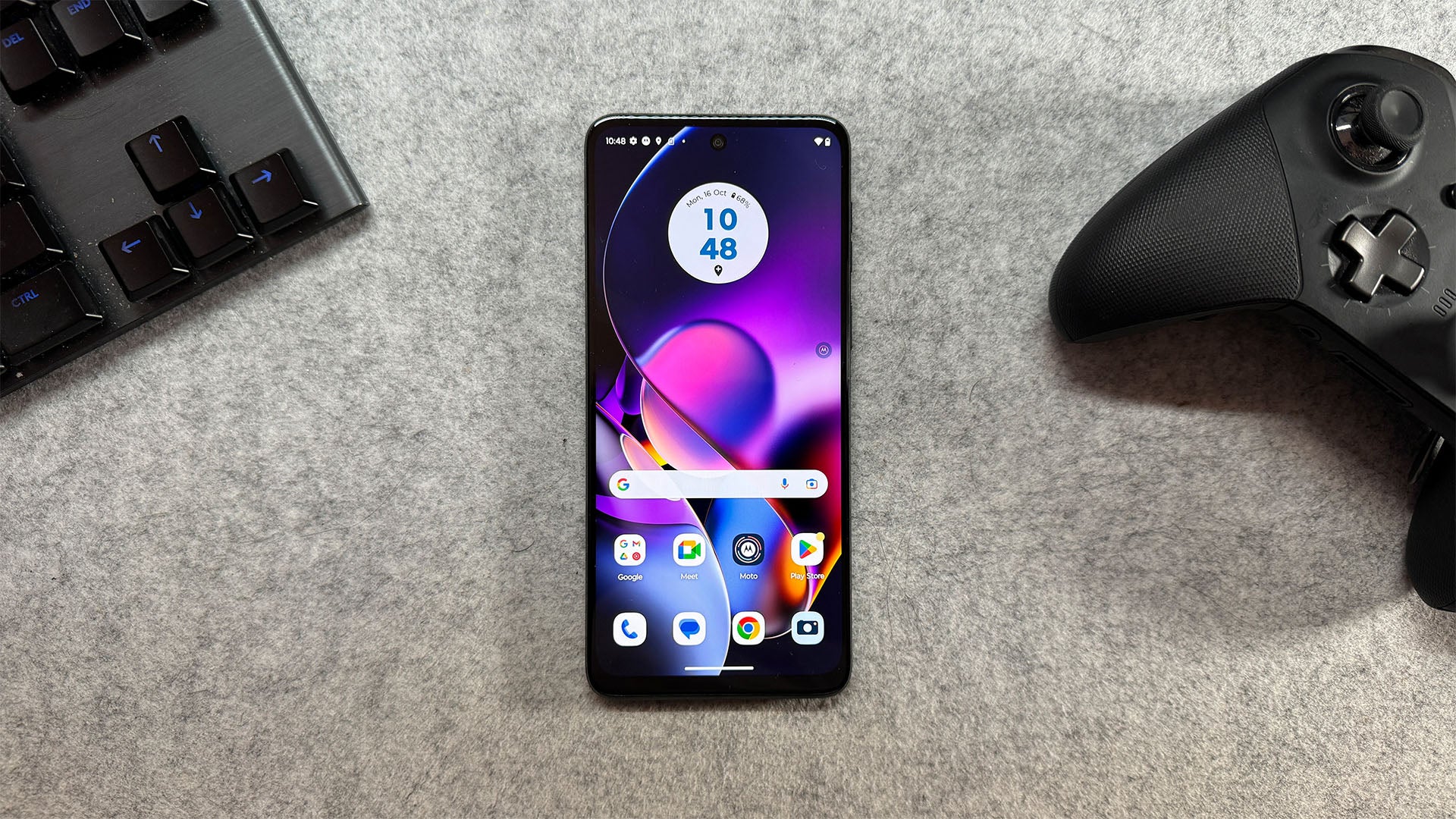




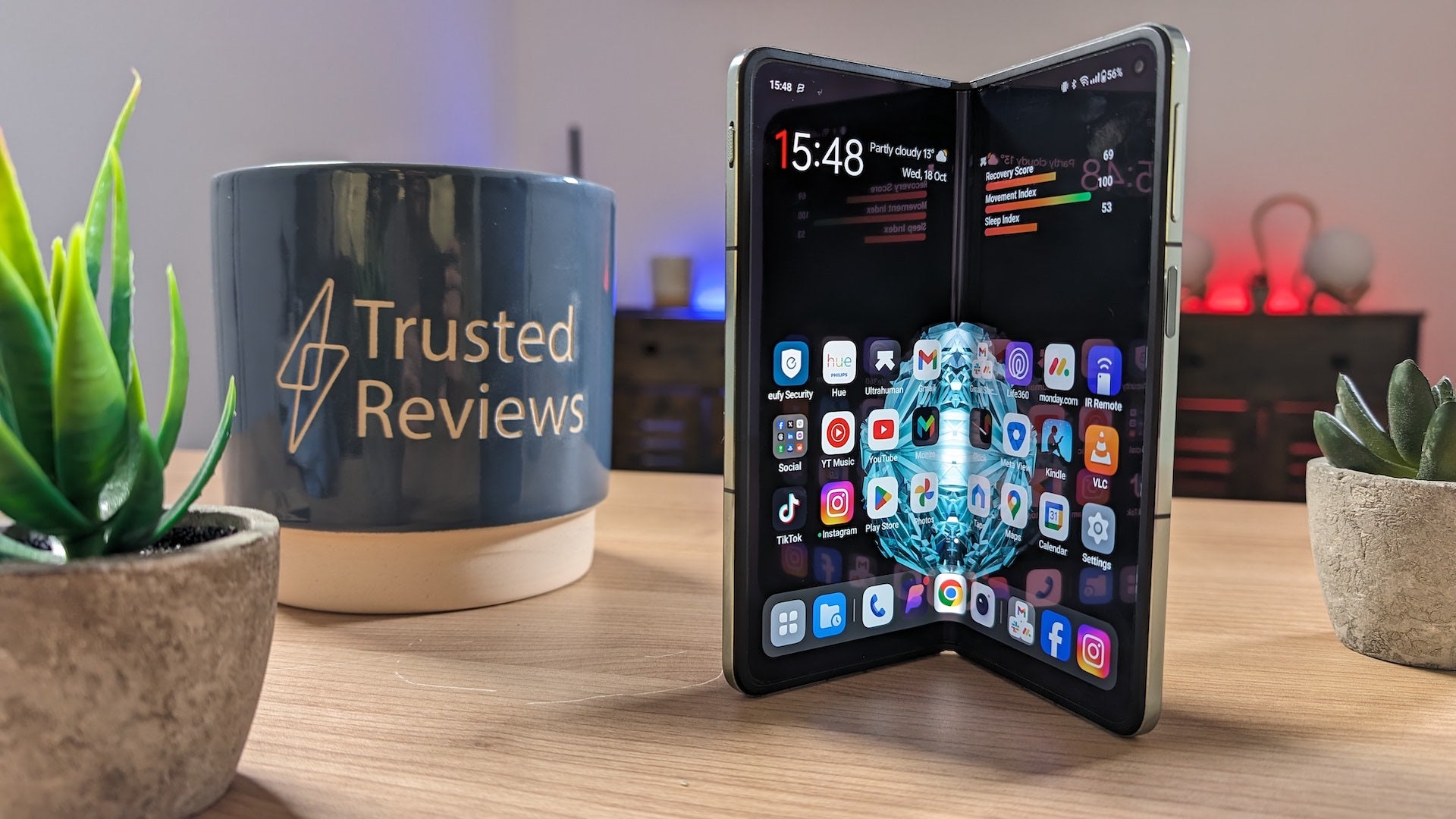

0 Comments